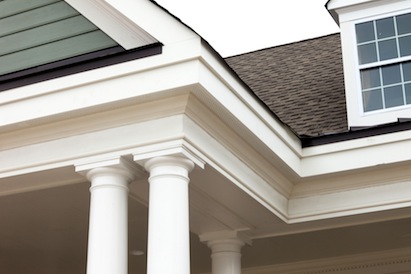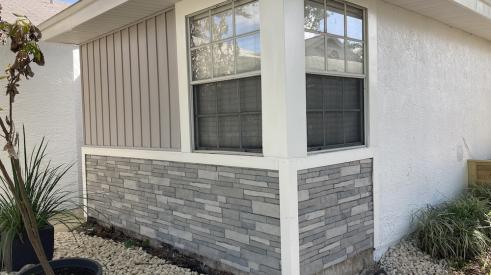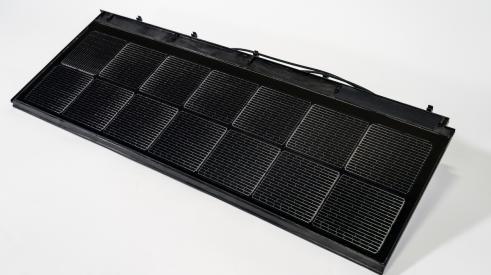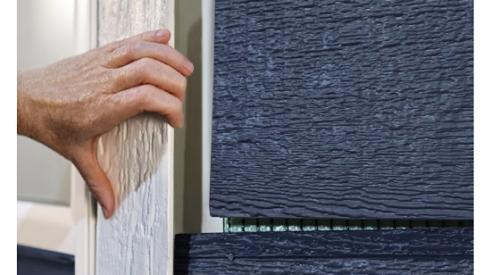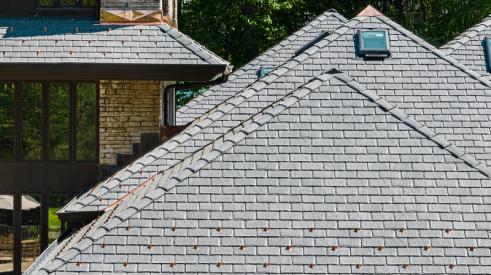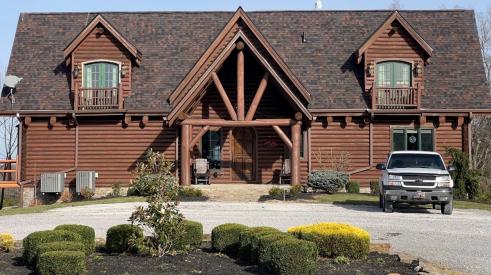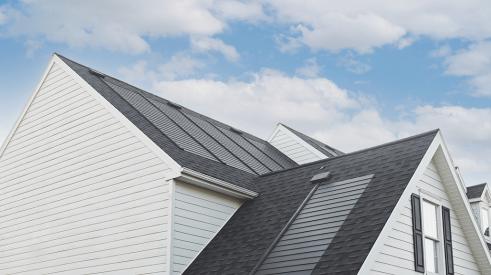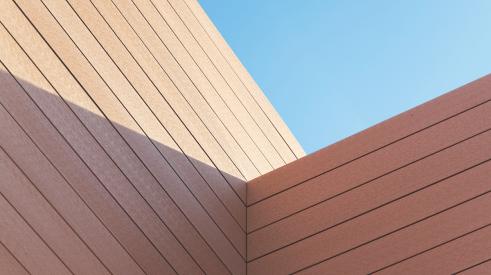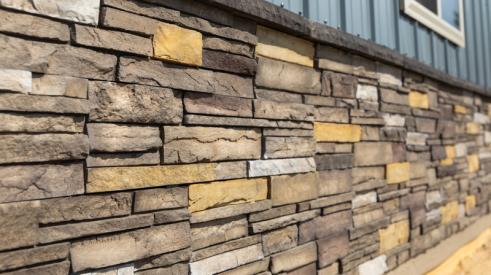With more of today’s homeowners staying put in their homes longer, the general trend in the home construction market has moved away from building one’s dream house and toward renovating their current home to fit their dreams. And for the siding segment of the building products market, that has meant an expansion in siding materials in all types, sizes and colors.
“We’ve seen a greater tendency or desire by homeowners to mix materials,” says Scott Rasmussen, president of Quality Edge. “People are using sections of steel, aluminum, stone or brick along with vinyl or fiber cement siding to get just the right look.” Most often this mixing and matching is most prevalent around the entryway of a home, where small amounts of a more expensive material like real or synthetic stone or brick can make a big impact and a strong design statement and provide consumers with a lot of bang for their bucks.
Also, with sprawling McMansions falling out of favor and the average size of an American home actually decreasing for the first time in about 30 years, people are looking to gain a little more living space through the use of outdoor rooms -- and that has also increased the mix-and-match mentality of many of today’s homeowners.
“From a design standpoint, this means that siding serves as the ‘backdrop’ of outdoor rooms,” says Drew Brandt, director of product marketing for CertainTeed. “So it is important to coordinate colors, profiles and styles with other outdoor living products such as decking, railing and fencing.”
Promising points in a flat market
Generally, material choices still follow regional trends that have been in place for several years; the East and Midwest are still big vinyl markets, brick is popular in the South, and natural wood siding remains strong in the Northwest. But with the blending of materials and homeowners who move across country bringing their backgrounds with them, those regional trend lines have gotten pretty blurry.
What transcends regional design tastes today is value – and that is largely driven by today’s economy. “It’s easy to say, ‘People have less money, so they are willing to spend less money.’ While that may be true to a certain extent, it doesn’t mean people are less willing to spend money across the board,” says John Dybsky, James Hardie product manager. “We’ve found that more than anything, consumers want a good value to cost ratio – not the least costly option.”
That means that vinyl, with its combination of lower cost and even lower maintenance, is expected to remain the strongest siding choice for the foreseeable future. According to 2009 U.S. Census data, it has been the number one cladding choice on new single-family homes for the last 15 years. But people are increasingly upgrading their vinyl to include thicker panels, darker colors and specialty accessories. “The look of shake is gaining in popularity,” says Jonathan Wierengo, director of marketing for The Tapco Group and The Foundry, a vinyl siding manufacturer. “The combination of durability and authenticity with cedar-inspired vinyl products has proven very popular.”
The Foundry’s Weathered Collection Shakes and Shingles feature a darker hue in the grain and a lighter hue on the higher points to create an authentic texture. And Wierengo says that construction of these products from self-extinguishing PVC is appealing to those homeowners across the country who are rebuilding after suffering damage during some of the severe fire seasons in recent years.
Ply Gem has also introduced a new hand-spilt shingle siding in their Variform, Napco and Georgia-Pacific brands. The various color options plus a random shingle pattern and staggered butt edge are designed to recreate a rustic, hand-crafted look. Ply Gem has also expanded their Variform by Ply Gem Ashton Heights collection to include four new darker hues to meet buyers’ desire for richer color schemes in their cladding.
“Dark colors on siding are gaining in popularity,” says Jerry Blais, vice president of marketing for the Ply Gem siding group. “Manufacturers now have the ability to infuse color during the extrusion process, resulting in lasting color performance even after years of exposure to sun and weather.”
Fiber cement will be the key competitor to vinyl in the coming years. A study released last year by the Freedonia Group in Cleveland said that while fiber cement won’t overtake vinyl any time soon, it will continue to take market share in a flattened siding market. “There are many homeowners who are now thinking more about the future of their current house versus plotting their next move,” says James Hardie’s Dybsky. “What that means is that homeowners are making choices that will take them through the longer term and they’re looking for durability, design options and low maintenance.”
More focus on accessories
Dybsky says that James Hardie’s siding with their ColorPlus factory-applied, baked-on paint that features a 15-year warranty is appealing to more and more consumers. The company has also introduced new HardieTrim Fascia boards with a slotted back to accept HardieSoffitt panels. This eliminates the need to nail through the visible portion of either material, thus eliminating the need to touch up the factory finish after installation.
Siding accessories of all materials are also getting more attention from buyers as another way to personalize their home. Low maintenance is still the watchword, but thicker and more elaborate profiles, wood graining and an endless palette of colors have homeowners using trim and accent pieces with dramatic intentions – and effect.
“Homeowners are moving toward trim as the latest way to use dimension and contrasting colors to distinguish a home,” says Wierengo. “Today’s use of trim gives homes a very noticeable upgrade in appeal.”
Cellular PVC trim has established a strong foothold in this arena, and Wierengo says The Tapco Group’s IQm brand promises no need for sanding and painting, won’t warp or rot, and is backed by a limited lifetime warranty. “It provides distinction while complementing siding materials such as fiber cement, wood or vinyl.”
Green growth and looking ahead
The green movement is now firmly entrenched in every aspect of the building market, and siding is no different. Manufacturers continue to develop new process and products to meet consumer demand for products that are sustainably manufactured, safe for the environment, and save on their energy bills. CertainTeed’s Brandt, says that homeowners are increasingly demanding energy efficient products that will help them reduce the overall carbon footprint of their home, and siding needs to fill the bill.
“As homes start to be graded on their green content, a more environmentally friendly siding product will mean higher resale value, tax credits, and lower energy bills for the homeowner,” says Brandt. CertainTeed’s fiber cement siding qualifies for LEED and NAHB green building credits with it’s 50 percent recycled content, and now the company has introduced CedarBoards six-inch insulated vinyl siding with 60 percent recycled content – the highest content of any vinyl cladding product and the only one to qualify for LEED and NAHB credits.
Within the vinyl segment of the siding market, the insulated category is expected to grow over the next few years. Insulated siding is specifically listed as eligible in the version of HomeStar legislation approved by the U.S. House of Representatives and the Vinyl Siding Institute is leading efforts to get the government to allow tax credits for insulated siding.
“We actively support both of these initiatives because insulated siding improves the energy efficiency of America’s homes and creates jobs,” says Jery Y. Huntley, President and CEO of VSI.
Even with the energy efficiency tax credits due to expire soon, most industry insiders agree that all signs point to a continuing of the green trend in general, and energy efficiency specifically. “Energy efficiency will continue to be top-of-the-mind for homeowners and remodelers,” says Brandt. “And siding will have a role to play in this trend.”
And many other signs point to a future on the upswing for siding makers and installers. The July 2010 Leading Indicator of Remodeling Activity (LIRA) released by the Remodeling Futures Program at Harvard’s Joint Center for Housing Studies said that homeowner confidence is leaning toward a trend in increased home investments and home improvement spending is expected to grow through early 2011. And as homeowners wait for the new housing market to rebound, they will be looking for ways to make their homes stand out from the crowd.
“We anticipate that the use of mixed materials will continue to grow,” Blais says. “When the time comes to sell, the designed exterior concept will make their homes more noticeable.”
The mix-and-match approach to home siding is still popular, and manufacturers are
offering new ways to meet consumer demand
Add new comment
Related Stories
Pro's Picks: A Quick Install Composite Stone
This pro completed a high volume facelift project months ahead of schedule
Innovative Products: Durable, Low-Profile Solar Shingles
Conventional solar panels are already outdated
· sponsored
Siding trim innovations to save time and hassle
Diamond Kote introduces innovative trim designed around installer wants
· sponsored
Contractors Embrace Province™ Slate
4 Colorful Takeaways from Roofing Contractors
Why residential roofing contractors are more mindful of color when it comes to shingle selection
5 Roofing Trends Discovered at IRE 2023
Observations made from the show floor of the largest roofing event in North America
Innovative Products: GAF Energy Timberline Solar Shingles
GAF Energy’s latest innovation has taken the solar world by storm
Innovative Products: Modern Mill ACRE Siding
A wood alternative that’s easy to use, durable, and green
· sponsored
Why Homeowners and Pros Prefer Stone Veneer to Stone
With the depth of selection in Westlake Royal Building Products, builders and homeowners have an almost-endless range of design possibilities to explore. Ben Drury, Product Development Manager for their exterior product brands, explains why Versetta Stone is so effective in so many different applications.



